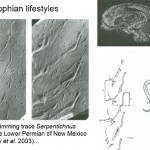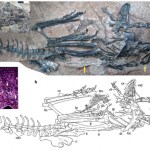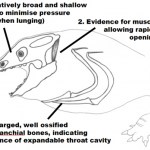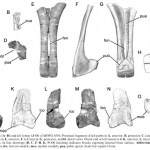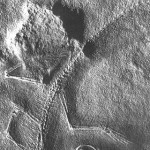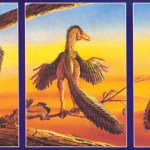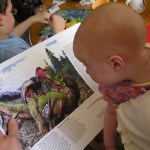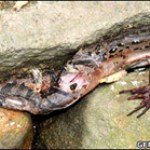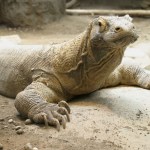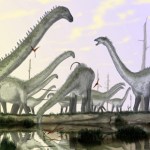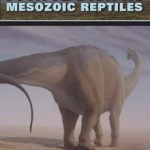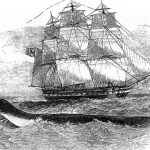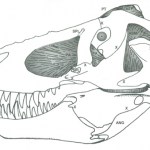
At some stage, I'll have to write full-length articles on lysorophians, aïstopods, the remaining temnospondyls, nectrideans, microsaurs, and assorted other groups of Palaeozoic and Mesozoic non-amniote tetrapods. Alas, this hasn't happened yet. In the meantime, here are some slides from one of my talks...
Lysorophians are peculiar, long-bodied lepospondyls from the Carboniferous and Permian, best known for Brachydectes. They had strongly reduced limbs and limb girdles and elongate skulls, typically with a strongly emarginated cheek region. Trace fossils suggest that some species were…
Oh, what the hell: given that we've already covered a new Wealden theropod, and have looked a bit at the palaeobiology of Majungasaurus within the week, I may as well resist my urge not to do more dinosaurs. In other words, I may as well cover Limusaurus as well, despite my previous protestations. It is, after all, a pretty incredible animal. Limusaurus is a small, long-legged dinosaur with short, gracile forelimbs, tiny hands, a slender neck and tail, a short, deep skull, and a slender lower jaw with a down-curved tip. It is toothless, and beak tissue is preserved around its jaw margins.…
I've had no time to complete any new articles, and after the text you're reading now - originally intended to be a comment appended to Cute, furry, has claws, bites - got to reasonable length, I thought I may as well turn it into a brief article. I'm still not sure how a long thread on identifying a rodent became subverted by a discussion on Cretaceous theropods, but anyway... [adjacent image from Andrea Cau's Theropoda]
If you followed the comments, you'll know that several Tet Zoo regulars (including Michael Ericson, Zach Miller and Thomas Holtz) have been discussing the possibility that…
I think I said recently that there have been way too many dinosaurs on Tet Zoo lately. It isn't that I don't like dinosaurs: it's just that I aim to provide balance and, let's face it, writing about charismatic megafauna all the time - especially dead charismatic megafauna - doesn't help. However, I'm sure you'll all forgive me for discussing my own published research. Last week another new paper came out with my name on it; hey, I'm fourth author of four, but it all counts, right? It's on another new bloody dinosaur...
Given that I write on Tet Zoo about such diverse subjects as the global…
I'm sure you'll agree that there have been way too many dinosaurs on Tet Zoo over the past few weeks. Let's balance things out by showing a cute little rodent. Your challenge: to identify it to species and - if at all possible - to say something quite interesting about the animal, or about the group to which it belongs. Good luck, and don't stop until we get to 100 comments...
On Monday night I went to the cinema and watched the new environmental movie The End of the Line, directed by Rupert Murray. Featuring habitats, scientists and case studies worldwide, it shows how our rampant and poorly controlled (or uncontrolled) exploitation of the global oceans is depleting (or has depleted) fish stocks to unsustainable levels. Nearly a third of global fisheries have crashed to date, and it is estimated that global fish stocks will be commercially extinct by 2048. Hopefully you will already know this: if not - well, perhaps it's time you started caring. Sorry, this post…
In the previous article we looked at the Birds Come First, or BCF, hypothesis. It goes without saying that BCF has not won acceptance in the community, nor - in fact - is it even familiar to the majority of archosaur workers. Here, we take a critical view of BCF: does it stand up, or does it fail?
To begin with, let me note that the underlying premise of BCF is fundamentally problematical: the idea that there is some sort of 'central trunk' (Olshevsky 1994, p. 42) or single, unbroken lineage that extended from the first stem-archosaur to the most recently evolved, modern bird. Old 'family…
A substantial amount of evidence demonstrates that birds are theropod dinosaurs, and that birds evolved during the Jurassic from small, feathered maniraptoran theropods closely related to dromaeosaurids and troodontids (known collectively as deinonychosaurs) [the small dromaeosaurid Microraptor shown in adjacent image]. The precise details of avian origins remain the subject of debate, and argument continues over whether proto-birds were tree climbers, leapers, terrestrial cursors, or combined some of these lifestyles. But because basal deinonychosaurs were small animals (not much different…
Here's a recent photo showing the proofs of one of my books. These particular pages (which focus on the 'dinosaur renaissance' of the 1960s and 70s) feature a Luis Rey piece: as usual, poor Tenontosaurus is getting dispatched by a Deinonychus gang. As you can see, Emma thought the picture looked neat (Will plays with Lego power miners in the background. The photo has already been featured here at Querencia)...
I sent the photo round to a few friends. Comments so far have included "I think it's more she is querying the extent of feathering, surely?", "That is beautiful * you will get it…
The big buzz in the cryptozoology community right now concerns a piece of footage taken on May 31st 2009 at Oakledge Park in Burlington, Vermont, and on the shore of Lake Champlain. Lake Champlain is famous in the world of lake monster research as it's alleged to be home to a large, long-bodied animal of some sort: for a previous discussion see my article on the Mansi photo (easily the best known image purporting to show a large, unidentified animal in the lake). The new film was taken by Eric Olsen on his mobile phone: the original version is viewable here on youtube, but can no longer be…
Since the publication of Taylor et al. (2009) - the sauropod neck posture paper - we've been running a whole series of articles on necks and neck posture, and all that it implies, over at SV-POW! Please check it out. I've been too busy to contribute anything, but that changes later today. Sorry, this is an annoying teaser...
Oh - while I'm here... I've been informed by Morgan Wirthlin that I've been nominated for the 3 Quarks Daily awards. Please go here for the link to the voting area. I never win these sorts of things so find it hard to get excited, but thanks for the nomination (and…
Last year was Year of the Frog (nothing to do with the Chinese calendar, but instead a global effort to raise awareness about the plight of the world's declining amphibian species). I hope that you've not forgotten that the global effort to slow amphibian extinction continues unabated. For various reasons, I haven't blogged about amphibians for a while, so, in an effort to bring balance (something I strive for, yet will always fail to achieve) I feel the need to bring you up to speed. What has happened lately in the world of amphibian conservation? [Pirri harlequin frog shown here: a species…
Welcome to one of those annoying teaser posts - I'd post something substantive, if only I had the time.
But I don't.
The adjacent photo shows Pristimantis charlottevillensis, a strabomantid from Tobago that was named in 1995. Believe it or don't, strabomantids are sometimes known as squatting prophet frogs. The group was only named in 2008, and was previously included within the hyloid group Brachycephalidae [previously discussed here].
The photo was taken by John C. Murphy and is used with his kind permission.
Hey - how do people get those open thread things going?
The proofs for one of my books arrived the other day, so I have been busy busy busy. This (in part) explains the lack of action here on the blog, and the preponderance of recycled stuff. Sorry about that. In fact, sorry, here's another recycled article from Tet Zoo ver 1. Hopefully I'll have the time to produce some new content over the next week, but don't hold your breath. And sorry about all the dinosaur stuff: I know you much prefer it when I post on frogs, lizards, mice and passerines. Anyway...
As a kid I always got the impression from textbooks that the only tetrapods (and thus only…
Today sees the publication of a new paper by Michael P. Taylor, Mathew Wedel and myself in which we make a bold and controversial claim: based on data from living animals, we contend that the necks of sauropod dinosaurs - all sauropod dinosaurs - were most likely held habitually in erect poses, and not in horizontal or sub-horizontal poses (Taylor et al. 2009). This research should of course be significant if you're interested in knowing what sauropods looked like when they were alive. However, it also impacts on hypotheses about sauropod behaviour, physiology and ecology [image below by the…
No time to produce anything new, so here's another recycled book review...
While the Mesozoic strata of Patagonia are particularly well known for their diverse and often spectacular dinosaurs, they have also yielded a phenomenally rich record of other Mesozoic reptiles, including turtles, squamates, plesiosaurs, ichthyosaurs, crocodilians and pterosaurs. In this multi-authored volume (another contribution to Indiana University Press's Life of the Past series), Gasparini, Salgado and Coria have edited a collection of 14 papers on the region's Mesozoic reptiles, and on their geological context…
Historically, an apparent absence of transitional forms has made it difficult to reconstruct the evolutionary affinities of the different modern avian 'orders'. As you'll know if you've been keeping up with the results of the various big molecular and morphological analyses - and who hasn't - the avian cladogram is gradually coming together, though areas of debate and disagreement remain. One of the most vexing areas has been the origin of the parrots, or psittaciforms. An idea frequently mooted in the ornithological literature is that parrots are close kin of pigeons and doves - the…
Here is a Secretary bird Sagittarius serpentarius skeleton I photographed some time ago: as usual, apologies for my terrible photography. The bird is lying on its back, and both its wings and legs are folded up. I would like you to concentrate in particular on its humeri: what the hell is going on?
Here's a close-up. Both humeri were like this. It looks as if they were broken mid-shaft, and then healed, but with the two halves of the shaft being totally misaligned (though I'm not saying that this is necessarily what happened: I really don't know). You might assume that a bird with injuries…
Like most scientific communities, the world of academic tetrapod zoology is an incestuous place. Inspired by a comment made here at Tet Zoo by Matt Wedel - co-author, colleague and one of the three SV-POWsketeers - Cameron McCormick (who works on guppies but is collaborating with Michael Woodley and yours truly on sea monsters) has a new post up at Lord Geekington that I find pretty interesting. Employing the new term 'phylogenetic roulette', he laments the fact that people are inclined to latch on to highly specific identifications when mystery animals are reported, even though critical…
Few dinosaurs are as well studied as the Upper Cretaceous tyrannosaurid theropod Tyrannosaurus rex. It might be easy to assume that this intense focus has been driven by the fame and glory associated with working on this dinosaur. That might be partly true but, in fact, T. rex really is one of the best known dinosaurs, represented by multiple individuals that are often near-complete and well preserved. It has also - in the form of bite marks, coprolites and soft tissue traces (or alleged soft tissue traces) - left us more evidence of its behaviour than many other Mesozoic dinosaurs. T. rex…
